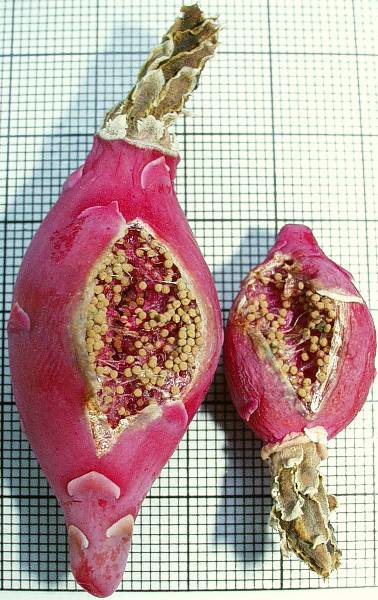|
fruits are juicy, deliquescent after ripeness (the usually small seeds stick to each other when drying), the Hilum-Mikropylar region is angular and/or callous, smaller or bigger than the diameter of the seed, the Cuticula of the seed hardly ever peels off
The focal points of circulation on the one hand lie in the area of the Andes from northwest-Argentina and Bolivia, and, on the other hand from the east end of Gran Chaco across south-Brazil towards Uruguay. Exceedance of the 18th degree of latitude is prevented by the wettish tropical climate (Cordillera Oriental). In the west, the Andes form an insurmountable barrier, in the northeast the Pantanal de Matto Grosso forestalls a further encroachment.
The character of the seed's testa-cells differs and is necessary as criterion for the subdivision into sections.
Subgenus II Microsemineum: Sectio B Saglioniana - Testa-cells tubercular or with papillae in the center, black to brown, outside walls not brittle, beamless till agleam
Sectio B Saglioniana is subdivided into 4 Subsectio, criteria are the shapes of seeds
Subsectio B1 Microsemineum: Seeds spheroidal, Hillum oval, with Elaiosom, Testa auburn till blackish
Based on the color of the flower's gullet and the Hilum-Mikropylar region, Subsectio B1 Microsemineum is subdivided into the following series:
--------- Series d - Mostina
--------- Series e - Saglioniana
--------- Series f - Chiquitana
--------- Series g - Chacoensiana
Subsectio B2 Macrosemineum: seeds helmet shaped, black, Testa-cells lack papillae, mostly with Elaiosom
Based on the color of the flower's gullet, Subsectio B2 Macrosemineum is subdivided into the 2 following series:
--------- Series h - Uruguayensia
--------- Series i - Multiflora
Subsectio B3 Pileisperma: seeds hat shaped, smooth, Testa-cells with papillae, with Elaiosom
--------- Subsectio B3 - B3 Pileisperma
Subsectio B4 Insertae sedis: both species G. bozsingianum and G. castellanosii are seed-morphologically located between Subsectio Microsemineum and Pileisperma. Both of these species are not assigned to one of the two subsections in this case, since it is not yet possible to determine if they are relics of a primal clan or young clans of hybrids.
--------- Subsectio B4 - B4 Insertae sedis
Sectio C Terminalia is subdivided into 2 Subsectio, criteria are the shapes of seeds
Subsectio C1 Terminalia: Seeds spheroidal, Hilum-Mikropylar-Region small
--------- Subsectio C1 Terminalia - C1 Terminalia
Subsectio C2 Schickendantziana: seeds helmet shaped, ample Hilum-Mikropylar region
Based on the shapes of seeds, Subsectio C2 Schickendantziana is subdivided into the following 2 series:
--------- Series j - Schickendantziana
--------- Series k - Periferalia
Sectio D Pirisemineum: Testa-cells smooth, without papillae, agleam, auburn till dark brown
--------- Sectio D Pirisemineum - D Pirisemineum
 |
|
fruit of G. mihanovichii
|
|
